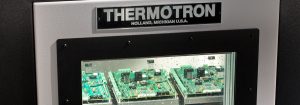
Two fundamental forms of environmental testing are simulation and stimulation. The differences, advantages, and applications of these types of environmental tests frequently cause confusion and debate.
Simulation mimics the conditions a product would see in its normal use environment. It is often referred to as “test to pass” because the environmental stresses applied to the product — such as temperature, humidity, and vibration — do not exceed the stresses it will face during its intended use. Once the product passes the simulation test, it’s ready for market or consumer use.
Stimulation uses stresses to uncover a product’s weaknesses and limits, often stressing a product to the point of failure and beyond. For example, the temperature within a chamber would gradually increase in an attempt to find the highest temperature at which the product under test will operate and where damage will occur. Once the product fails, it is determined whether the failure is acceptable or if it needs to be fixed prior to market introduction. Stimulation is also referred to as accelerated testing.
The following are some examples of different types of simulation testing:
Burn-In
Burn-In is a traditional form of testing where large batches of products are tested together at an elevated temperature to produce premature failures. Elevated temperature conditions are achieved using the heat from the products under test or from a heating element.
Burn-in tests are commonly done when the products under test are powered, and temperatures may be cycled occasionally, which causes some degree of thermal cycling as the devices heat and cool. The ease in which burn-in tests are implemented must be weighed against the relatively low screening effectiveness and long test times, which is why many companies are turning to temperature cycling.
Temperature Cycling
As demands to reduce testing time increase and the understanding of stimulation grows, companies are transitioning from burn-in to temperature cycling for testing electronics.
Temperature cycling is the rapid change between predetermined temperature extremes for multiple cycles. While temperature cycling is considered more effective and efficient than burn-in, there are a few complications to overcome. Good airflow, for example, is important because it maximizes heat transfer and ensures the increases and decreases in the actual product’s temperature follows the changes in the chamber air temperature. It also prevents the formation of hot and cold spots within the workspace of the chamber.
Ramp rate, or the speed at which the chamber can change the air temperature, is also an important consideration. Faster ramp rates are more effective stresses for a given number of cycles; however, if the ramps are too fast, they might cause undesired damage. A typical temperature profile transitions between -40°C and 125°C, at 5°C to 15°C per minute. At the temperature extremes, dwell periods (a period of time when the temperature is stable) are used to allow the product temperature to catch up to the air temperature.
Thermal Shock, a form of temperature cycling, exposes a small number of products to severe and extreme temperature changes. This normally is accomplished by moving the products between hot and cold zones of preconditioned air or fluid. Thermal shock can be used for design validation and pre-production validation testing.
ESS
Environmental Stress Screening (ESS) identifies weaknesses in manufacturing materials and processes by subjecting each product to stimulus while it is in production. The objective of stress screening is to eliminate products that would fail early in use to reduce product infantile mortality rates.
The following is an example of stimulation testing:
HALT and HASS
Highly Accelerated Life Testing (HALT) uses aggressive temperature change rates and multi-axis repetitive shock vibration to reduce required testing time. HALT tests a product to the point of failure to uncover product weaknesses, operating limits, and destruct limits prior to production. HALT is used to detect design defects in order to make design enhancements.
Highly Accelerated Stress Screening (HASS) is a production process used to screen out defective products prior to shipment. HASS uses similar — but less aggressive — stresses to those used in HALT. For more details on HALT and HASS, check out Thermotron’s Accelerated Stress Testing Handbook.
Overall, stimulation testing applies stresses to products, bringing them to their breaking points, to improve and ruggedize them. Simulation testing ensures products are reliable and will function as intended. Environmental testing is an important aspect of product design and development, so be sure to tailor your testing process to each product based on its design, materials, and intended use environment.